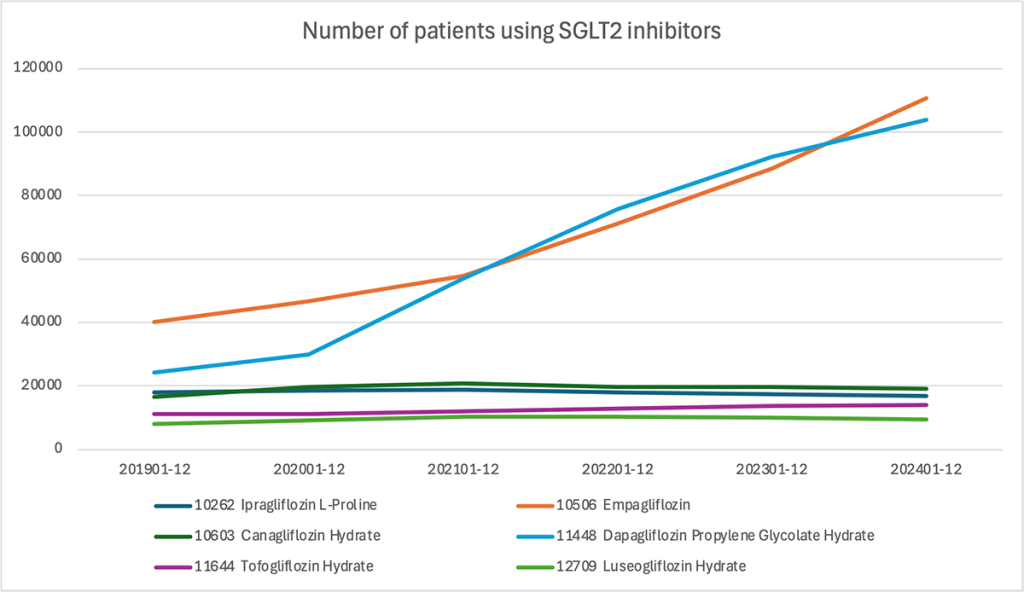
Trends in Patient Numbers for Type 2 Diabetes and Therapeutic Drug Usage: Focusing on SGLT2 Inhibitors
Diabetes is a representative lifestyle-related disease, and the number of patients in Japan is on an increasing trend.
The Japan Diabetes Society published the “Diabetes Clinical Practice Guidelines 2024” in 2024, which newly specifies the cardiovascular and renal protective effects of SGLT2 inhibitors and GLP-1 receptor agonists. This has further advanced the review of treatment strategies and the individual optimization of pharmacotherapy.
Every year, November 14 is designated by the WHO (World Health Organization) as “World Diabetes Day.” This day aims to raise social awareness about diabetes management. Additionally, the symbol of World Diabetes Day, the “Blue Circle,” represents “unity” and “hope,” symbolizing global solidarity in diabetes countermeasures.
In recent years, the expansion of indications and recognition of clinical utility for new therapeutic drugs, starting with GLP-1 receptor agonists, has broadened the range of treatment options. Therefore, using MDV’s DPC data, we analyzed the trends in the number of patients with type 2 diabetes, as well as the usage status of therapeutic drugs for type 2 diabetes, with a focus on SGLT2 inhibitors.

Right vertical axis: E10-E14 (bar graph), Left vertical axis: Disease name code (line graph)
Data target period: January 2019 to December 2024
Only hospitals where data for the specified year and month is fully available
Number of facilities meeting basic conditions: 359
Extracted the top 5 diseases with the highest patient numbers based on disease name codes among ICD-10 codes E11 to E14
From 2019 to 2024, the total number of patients with diabetes-related diseases has been around 1.7 million, showing a steady upward trend.
Among the top 5 diabetes-related diseases, “Type 2 Diabetes” has shown an increasing trend throughout the years, surpassing “Diabetes (Unspecified)” in 2024. “Diabetes (Unclassified)” is on a decreasing trend, possibly indicating progress in refining disease names for insurance claims.

January 2019 to December 2024
Only hospitals where data for the specified year and month is fully available
Number of facilities meeting basic conditions: 359
Cases diagnosed with ICD-10 codes E11/E14 (Type 2/Unspecified Type Diabetes) and confirmed use of ATC code A10 (Diabetes Therapeutic Drugs)
Among therapeutic drugs for type 2 diabetes, “DPP-IV Inhibitors” remain the most commonly used, but have shown a gradual decline since 2019. In contrast, “SGLT2 Inhibitors” have increased rapidly, reaching a level exceeding “Human Insulin and Its Analogs” in 2024. The spread of SGLT2 inhibitors can be attributed to the accumulation of evidence on their cardio-renal protective effects and the expansion of adoption in clinical settings due to guideline revisions. “Biguanide Diabetes Drugs” are also on an upward trend, maintaining their position as a foundational drug in combination therapy.

January 2019 to December 2024
Only hospitals where data for the specified year and month is fully available
Number of facilities meeting basic conditions: 359
Cases diagnosed with ICD-10 codes E11/E14 (Type 2/Unspecified Type Diabetes) and confirmed use of SGLT2 inhibitors
From 2019 to 2024, the overall number of patients using SGLT2 inhibitors has shown an increasing trend year by year. In particular, “Ipragliflozin L-Proline” and “Empagliflozin” were at scales of about 20,000 and 40,000 patients respectively in 2019, but expanded to over 100,000 patients each in 2024. Both drugs have shown significant growth since 2020. On the other hand, “Canagliflozin Hydrate,” “Dapagliflozin Propylene Glycol Hydrate,” “Tofogliflozin Hydrate,” and “Luseogliflozin Hydrate” have all shown relatively gradual trends, remaining stable at around 10,000 to 20,000 patients.
Overall, the prescription of SGLT2 inhibitors has become more established in clinical practice, with a usage trend centered on two main agents. The background for this increase includes the widespread recognition of their utility in heart failure and chronic kidney disease (CKD), in addition to their blood glucose-lowering effects as diabetes treatments. Furthermore, it is believed that prescription choices are becoming clearer due to guideline revisions and the accumulation of evidence for each drug.
Note: This article was published on November 4, 2025.
Data survey and analysis tailored to your specific requests
Databases, data analysis requests, and more.
© Medical Data Vision Co., Ltd. All Rights Reserved.





